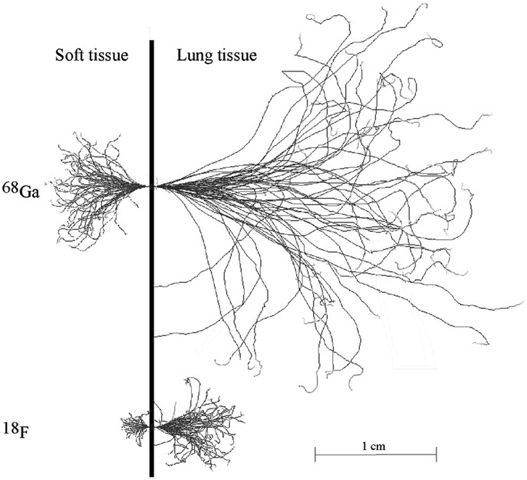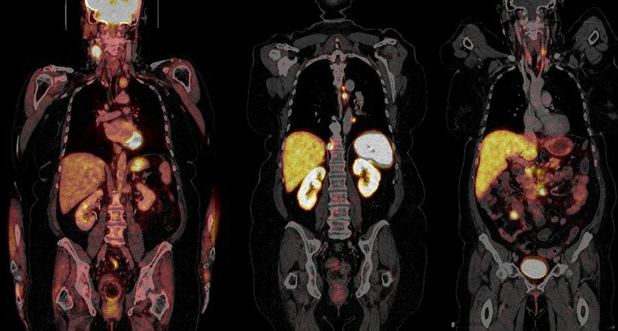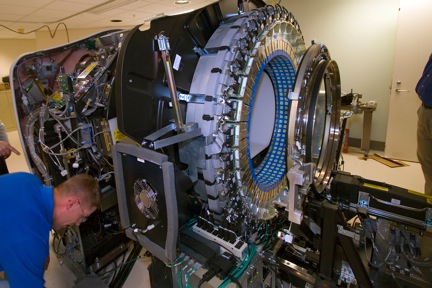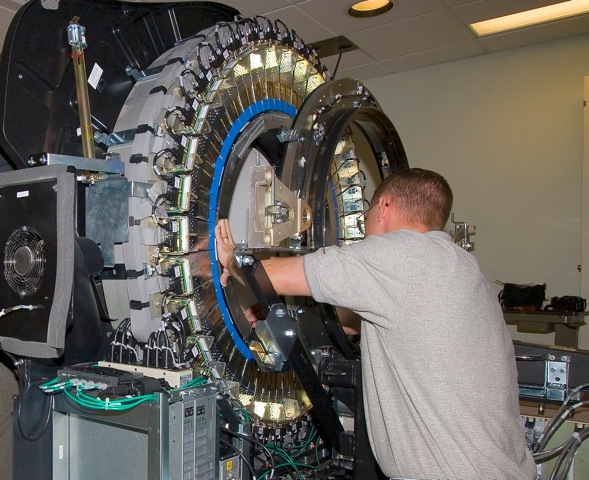Physics 428: Selected Topics in Physics
Imaging Detectors for Medical
and Health Sciences
Instructor: Paul Kinahan, PhD
Tues 6:30-8:50 PM, PAA 110
March 29 - May 31, 2016
SLN: 18521, 18522, 18523
Credits: 3
online lecture site
 |
 |
| positron tracks in tissue | PET/CT scans with with F-18 (left) and Ga-68 (center, right) tracers |
UW General Catalog Course Description: This course focuses on x-ray and nuclear imaging methods and their applications in medicine. Specifically, the course will cover the sources, detectors and applications in for medical imaging, including the fundamental concept of an imaging equation, the inverse problem of image formation, and image SNR. This is the third course (after PHYS 575 and 576) in the Applied Radiation Physics sequence.
Prerequisites / Recommended preparation: At least undergraduate freshman-level physics or chemistry, and some advanced coursework typical of engineering or science majors; calculus, algebra and trigonometry, and preferably PHYS 575 and 576.
Open to:
(a) Students matriculated in the UW Physics Evening MS Degree Program.
(b) Graduate non-matriculated students or Certificate student. Please contact UW Professional and Continuing Education
(c) Full or part time UW graduate students, from any college or campus.
(d) Advanced undergraduate science majors, * with instructor's permission *
Learning goals: Students will be introduced to the specific imaging methods of x-ray, gamma-ray, CT, SPECT, PET, and PET/CT imaging. By the end of the course students will have gained familiarity with the context and physics of medical imaging systems that use ionizing radiation i.e. x-rays and gamma rays.
Textbooks: There is no required textbook for this course. Reference articles and materials will be posted on the course website. The length and number of articles will be limited to ensure students have time to thoroughly read and understand the material.
Method of instruction: This course will combine lectures with a seminar-discussion format. Students may attend any session online via Adobe Connect. Attendance in person is recommended but not required. An optional field trip to a medical imaging clinic is planned, but not yet confirmed.
Additional instructors: William Hunter, PhD; Robert Miyaoka, PhD
Class assignments and grading: Midterm exam: Final paper and class presentation. Class participation in seminars and discussions.
Schedule (tentative):
| lecture | date | instructor | topic | CLASS Recordings |
| 1 | March 29 | PK | Overview: Imaging equation, inverse problem | Lecture 1 |
| 2 | April 5 | PK | 2D-LSI imaging systems, X-ray physics: formation and interaction | Lecture 2 |
| 3 | April 12 | WH | X-ray detection and imaging systems | Lecture 3 |
| 4 | April 19 | WH | X-ray computed tomography (CT) systems | Lecture 4 |
| 5 | April 26 | WH | X-ray CT part 2. Contrast Agents | Lecture 5 |
| 6 | May 3 | PK | Image reconstruction | Lecture 6 |
| 7 | May 10 | n/a | Image Quality and Radiation Dosimetry | n/a |
| 8 | May 17 | PK | Gamma cameras: components and systems | Lecture 8 |
| 9 | May 24 | PK | Tomography in molecular imaging: SPECT scanners | Lecture 9 |
| 10 | May 31 | WH | Positron emission tomography (PET) and hybrid PET/CT scanners | Lecture 10 |
Additional Class Materials:
The Role of Biomedical Imaging in Future Healthcare Scenarios
A report by David S. Lester,
Director Pfizer Human Health Technologies, 2006
Weissleder and Nahrendorf “Advancing biomedical imaging"
P Natl Acad Sci Usa, vol. 112, no. 47, pp. 14424–14428, Nov. 2015.
Radiation risks of medical imaging: separating fact from fantasy
Hendee and O'Connor. Radiology (2012) vol. 264 (2) pp. 312-21
Innovations in Treatment Cardiovascular Disease Part 2
Online UWTV lecture on CT for cardiac studies April 22, 2008 by Dr William P Shuman

